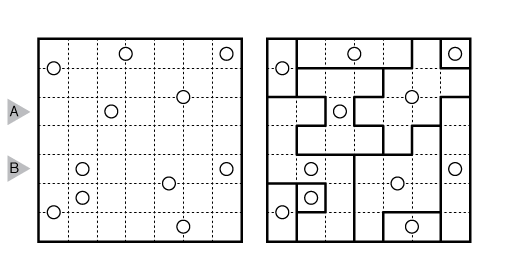Spiral Galaxies Rules and Info

Rules: Divide the grid along the indicated lines into connected regions – “galaxies” – with rotational symmetry. Each cell must belong to one galaxy, and each galaxy must have exactly one circle at its center of rotational symmetry.
Answer String: Enter the number of cells in each connected group (between bold lines) in the marked rows. Separate each row’s entry from the next with a comma. The example has the answer “2131,331”.
(Brief) History of Spiral Galaxies: Spiral Galaxies was first published in 2001 by Nikoli in quarterly Communication 96 under the name 天体ショー (‘Tentai Show’). The original author was Rヲボコップ (‘Robocop’). The puzzle name has two meanings. In Japanese “Ten” means dot and “Tai-show” can refer to symmetry, describing the puzzle rules. “Tentai” also refers to astronomical things, and the puzzle grids resemble constellations. By marking dots in different colors, the puzzle can sometime hides a picture in its solution. At Grandmaster Puzzles, we focus on logically distinctive themes and do not typically include shading instructions.
History of this example: This simple Spiral Galaxies puzzle was written as an example by Thomas Snyder for The Art of Puzzles 2.
Sources for Spiral Galaxies Puzzles: Follow this link for classic Spiral Galaxies puzzles on this website and this link for variations on Spiral Galaxies puzzles. If you are new to this puzzle type, here are our easiest Spiral Galaxies Puzzles to get started on. More Spiral Galaxies puzzles can be found in The Art of Puzzles 2.
Design rules for contributors: A Grandmaster Spiral Galaxies will have a unique solution that can be reached by logic alone. Generally, a Grandmaster Spiral Galaxies should have an interesting visual theme or an interesting solution. Sizes from 10×10 and above are recommended (maximum aspect ratio of 2:1 if rectangular).
